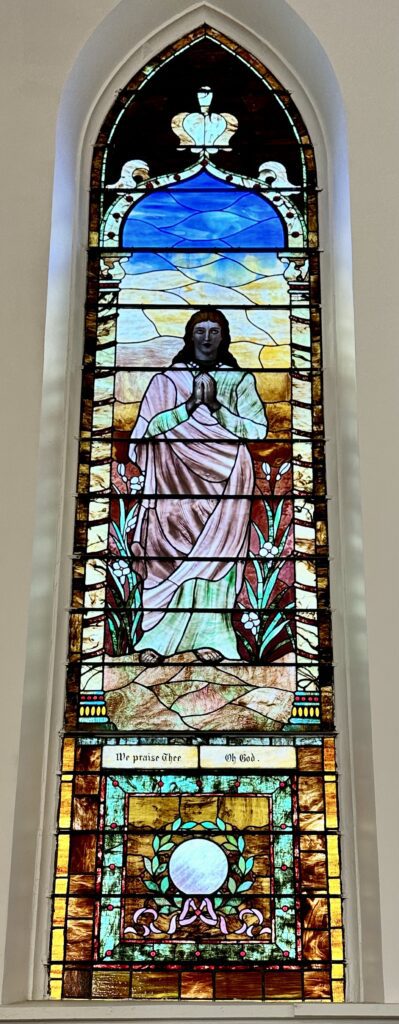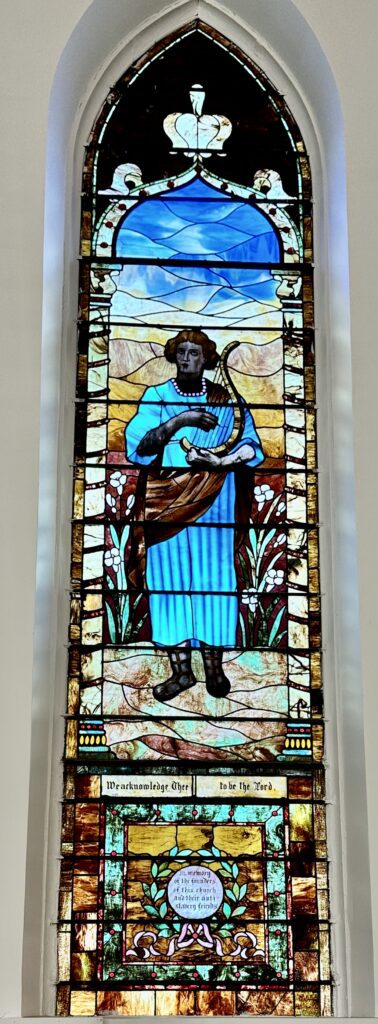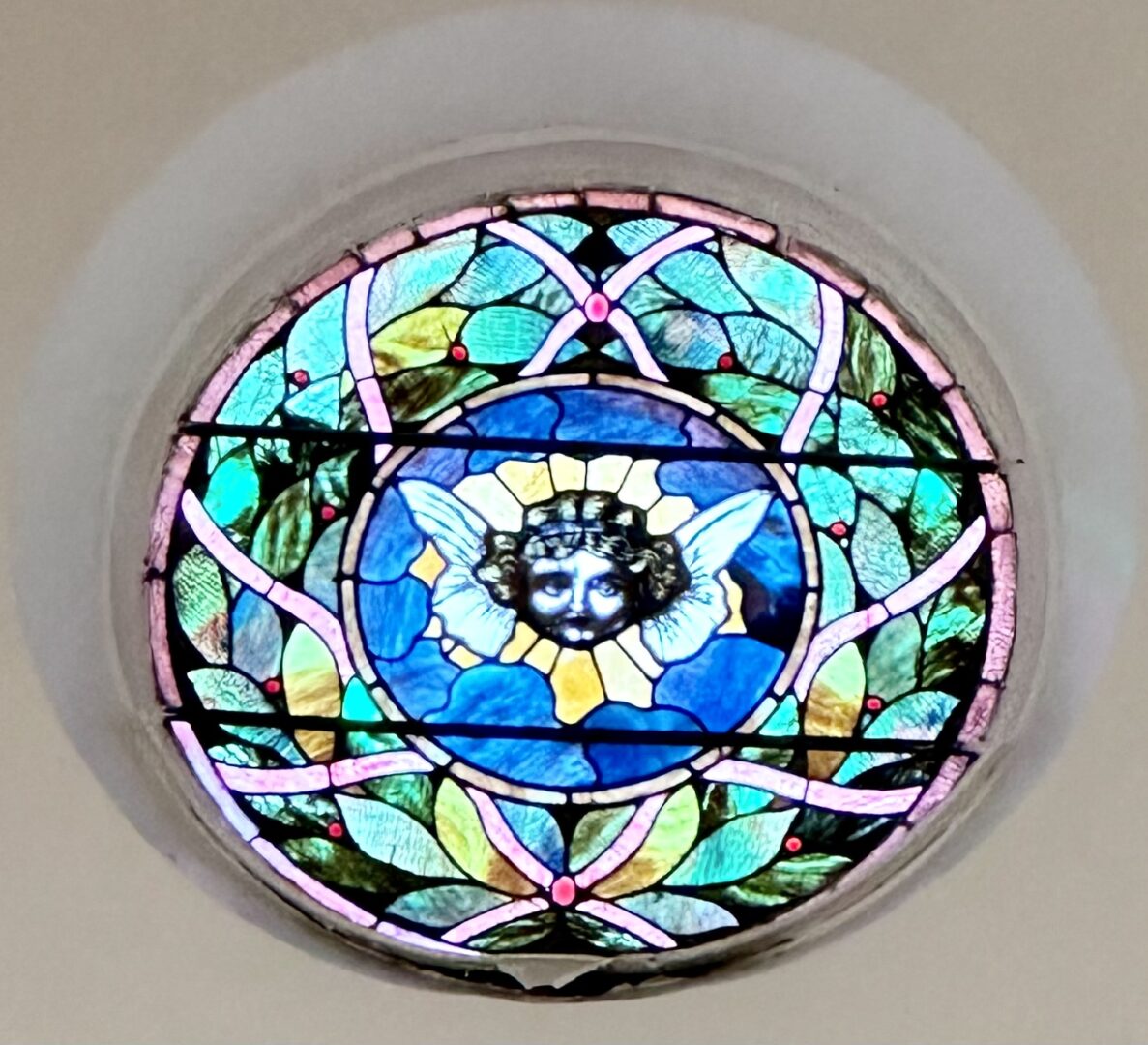Church History
A History of Love and Activism
Our first pastor, Rev B.W. Higbee was known as spiritual, evangelistic and militant for Christ’s love. So, it should come as no surprise that we were founded as an anti-slavery church in 1834. Our present building was built in 1868 featuring two prominent stained-glass windows depicting African Americans as Biblical characters and dedicated to the anti-slavery movement. In our over 180-year history we have never shied away from doing what is right for Christ’s love. We’ve marched for civil rights, stood up for peace, fought for equality of women, been at the forefront of LGBT rights in the county and helped those in need. We take very seriously Jesus’ supreme commandment to love God and to love our neighbors.
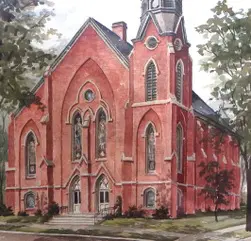
Holy Ground
Our church building is on the National Historic Register not only because it is old (built in 1868), but also because it is an architectural treasure. Stop by and visit our stunning sanctuary. From the high arched ceiling to the splendid stained-glass windows, it is aesthetically pleasing. The Spirit’s presence is palpable, exuding a deep sense of peace and Sacredness. It is truly Holy ground. First Congregational has been filled with the Spirit from the start and has been overflowing ever since.
When the local school district put together a walking tour of Mount Vernon, our church was one of the historical places they chose to include.
History of the United Church of Christ
A video about the history of the United Church of Christ: “Yesterday's Visionaries, Today’s Voices.”
Our Beautiful Stained-Glass Windows
Our Beautiful stained-glass windows were installed during the leadership
of Rev. William J. Turner who served the church from 1893 to 1898.
Many of them were dedicated in memory church members.

One of our members, Cliff Davis was inspired by this window to write the words and music to this song.
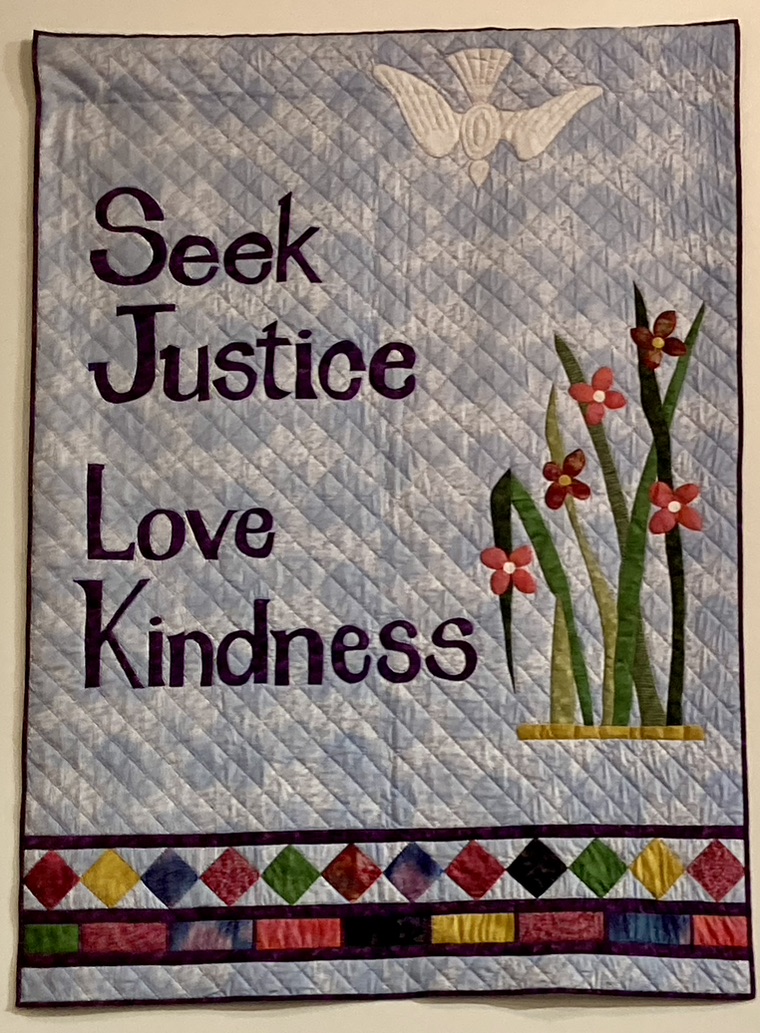
Our Mission
In 2011, our quilting group completed these two banners that we proudly hang in our sanctuary.
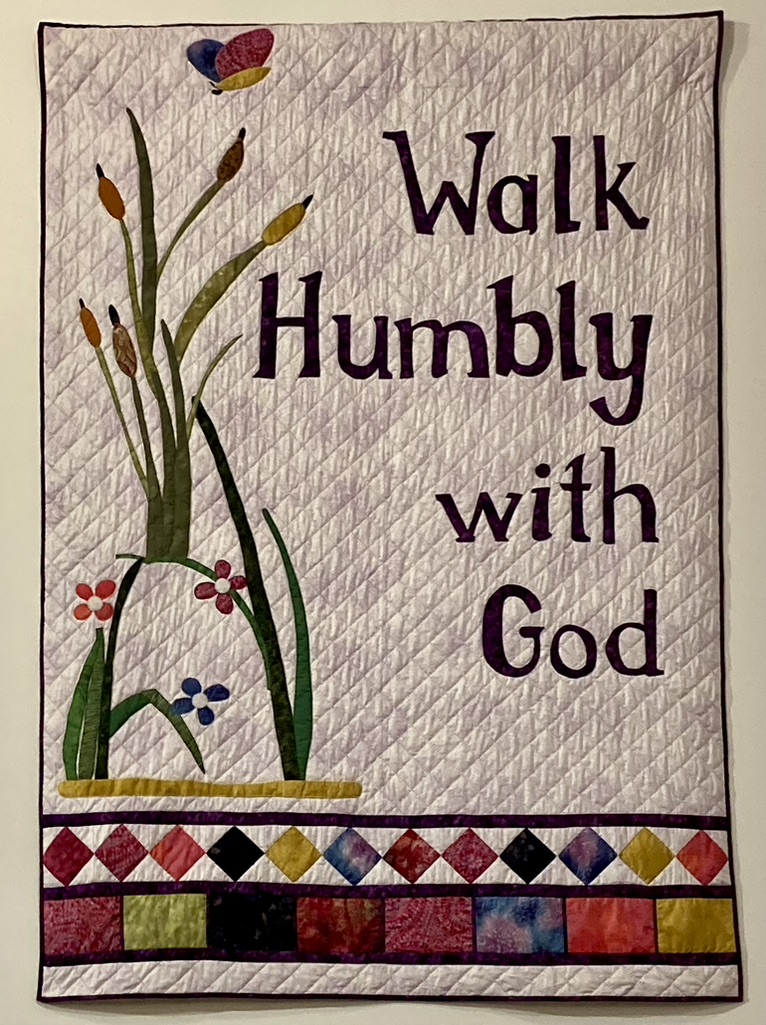
186 YEARS OF LOVING AND SERVING IN THE COMMUNITY - by Rev. Scott Elliott 2/6/2021
We stand on the shoulders of those who have gone before us. We are instructed, shaped, formed and influenced by our past – and the history we create shapes and influences those in the future. So, it’s good from time to time to look back and take in the path and the people that traveled it with God and Jesus to bring us to this very day. God and Jesus, of course, have influenced the arch of our history most of all.
We started as an anti-slavery church. A huge part of our first missions and ministries was to work and to strive for the freedom of American slaves. The first minister of the church born in the throes of our anti-slavery beginnings was Benjamin Higbee. There is no known photo of him but a note on our hall wall says this about him. Rev. Higbee is the only pastor we do not have a photo of.
Our church began in barn near Bangs on July 26, 1834. Our first church building in town was near where the library is now. We occupied that long gone place from 1835 to 1867. We do not have a photo of that building but I do have the photos of the other pastors who served in that location.
In that church we began as “The Free Presbyterian” until we became The First Congregational Church in 1849. The church did not just oppose the injustice of slavery, anti-Slavery advocates were also often involved in Temperance and Suffrage movements– and First Congregational Church embraced both. In the mid-1800s an early women’s rights activist, Amelia Bloomer, attended the church (“bloomers” are named after her). Lucy Stone, another Suffrage activist gave a lecture in the church on women in the workplace.
In much of the last decade, we were in the first building, from 1860 to 1865, our focus included gathering and preparing large quantities of supplies for Northern Armies during the Civil War.
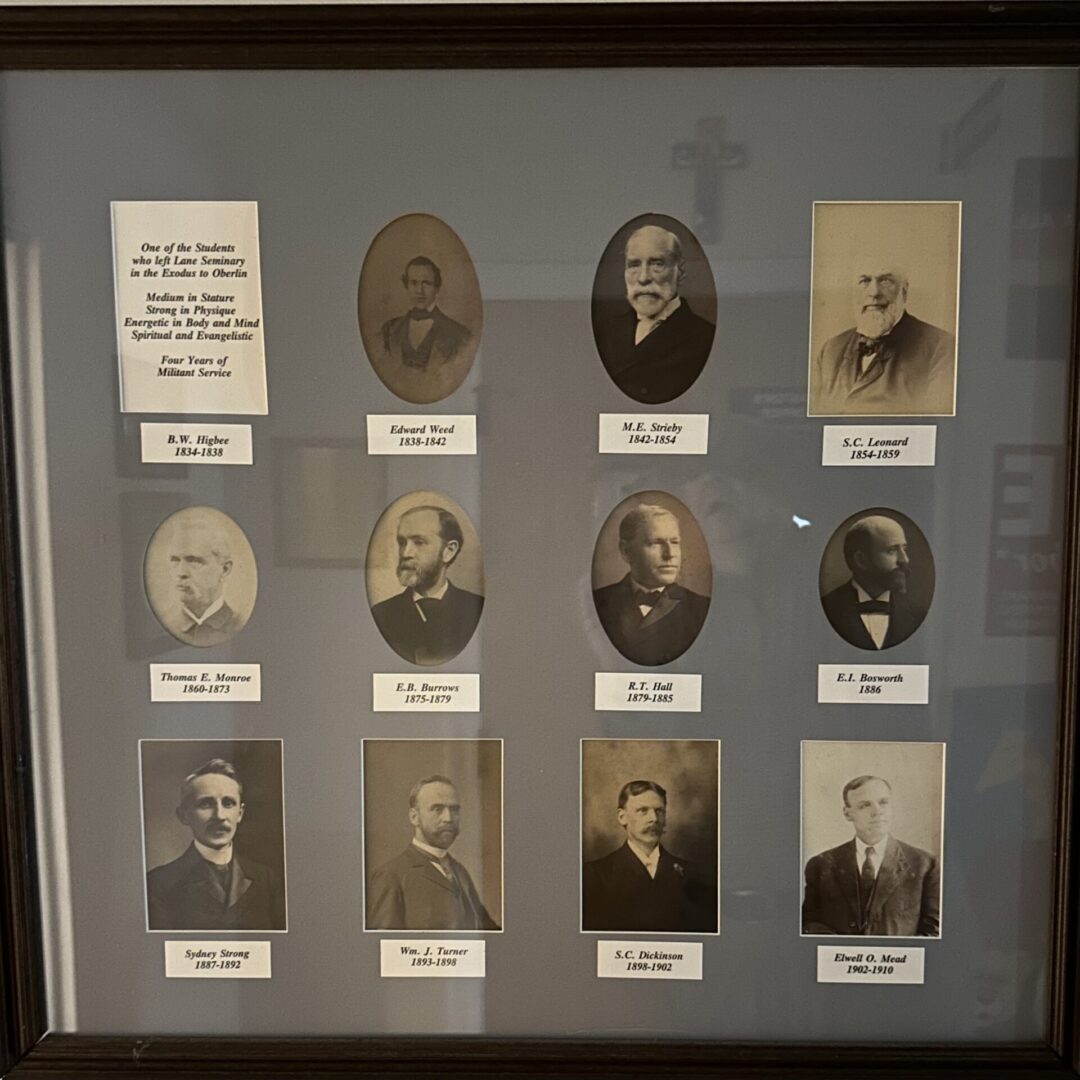
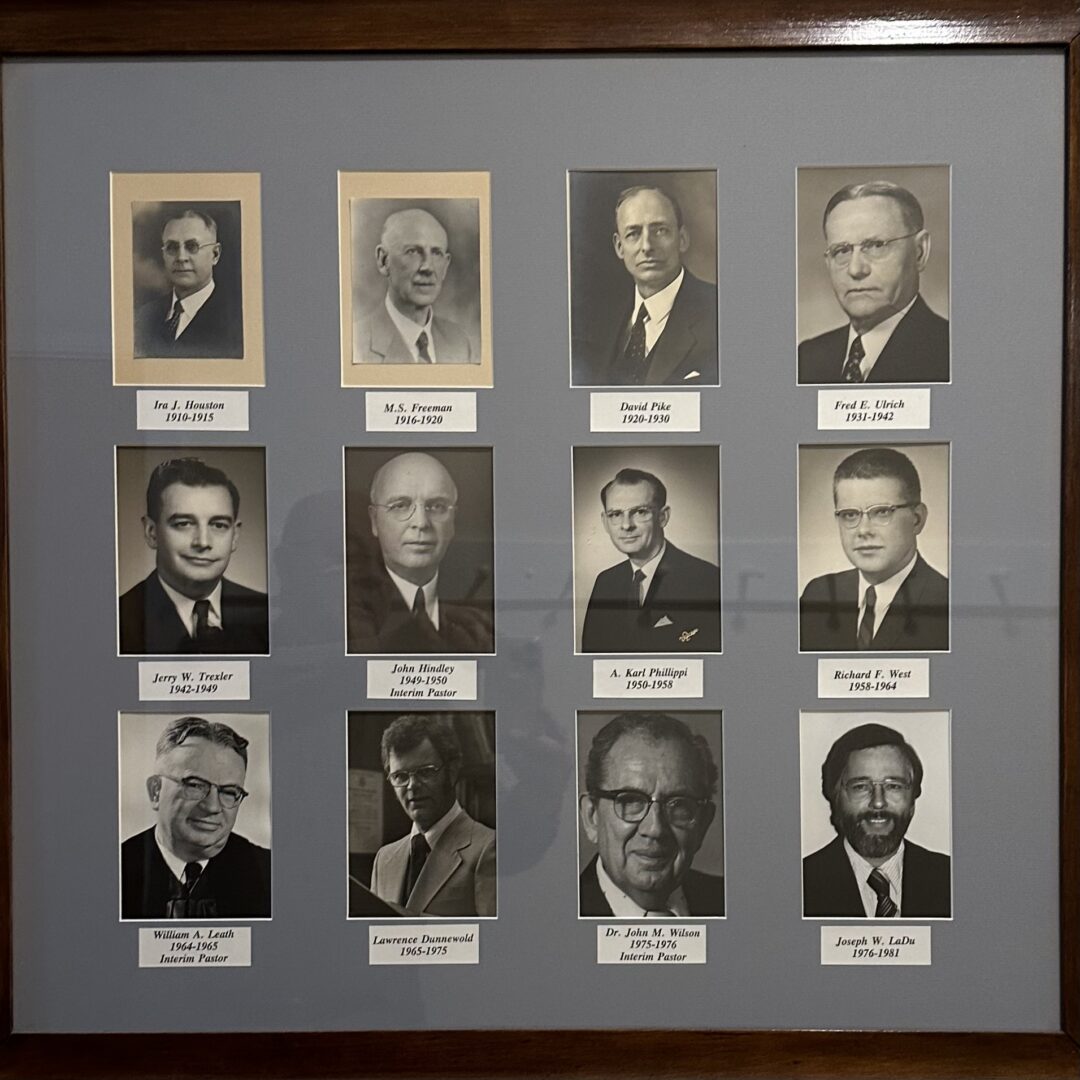
Shortly after the Civil War ended, in 1867, we sold the first church structure and moved out and into, believe it or not, the library, which used to be right across the street from here. We were in the library for a year while the new building – the current one we are in (200 North Main Street) was being finished.
It took three years to build this building – after that one year in the library, we moved into this place in 1868.
Although there is a 1950s rendering in the parlor of the early church showing a brick facade, as well as notes in the archives suggesting that stucco did not go over the bricks until after 1916.
Early photographs of the church actually suggest perhaps that stucco was on the front of the building earlier than 1916 the year the spire was removed.
Most of the pictures do not have dates, but we know the spire came down in 1916. So, all the shots with the spire were taken over a hundred years ago. Just look for the spire in these photos — it was one of the highest land marks in Mount Vernon.
In 1916, there was a fire in the spire caused by lightning and we decided to take the spire off and remodel a portion of the tower, adding some windows and changing the steeple tower roof line. You can see there were also some pyramid stacks of blocks on the four corners of the tower and a couple of points elsewhere.
Eventually the pyramids on the tower came down but if you look on the outside of the building you will still see some elsewhere. The tower has had different painting accents. One time the church front and tower had ivy on it.
Here are some highlights of the last 7 years. We fixed the social hall. We have a new floor and John Reiss fixed the walls. We fixed the bell tower and got the bell ringing again. We have a theatre ministry-that cool Christmas Eve skit, but we also did full-length productions of Godspell and A Christmas Carol. We added an Animal Blessing service each August. We have worked hard on justice issues, because of this church leadership and work on racial justice issues your pastor represented the church as keynote speaker in 2019 and was given a civil rights award–for our work together. We refurbished our sanctuary with new heating/air-conditioning, new sound system and all new paint and wall repair. We have held 5 Peace Village camps for children. What blessing this church is to one another, to the community and to God. May we add more good history to the community AMEN.
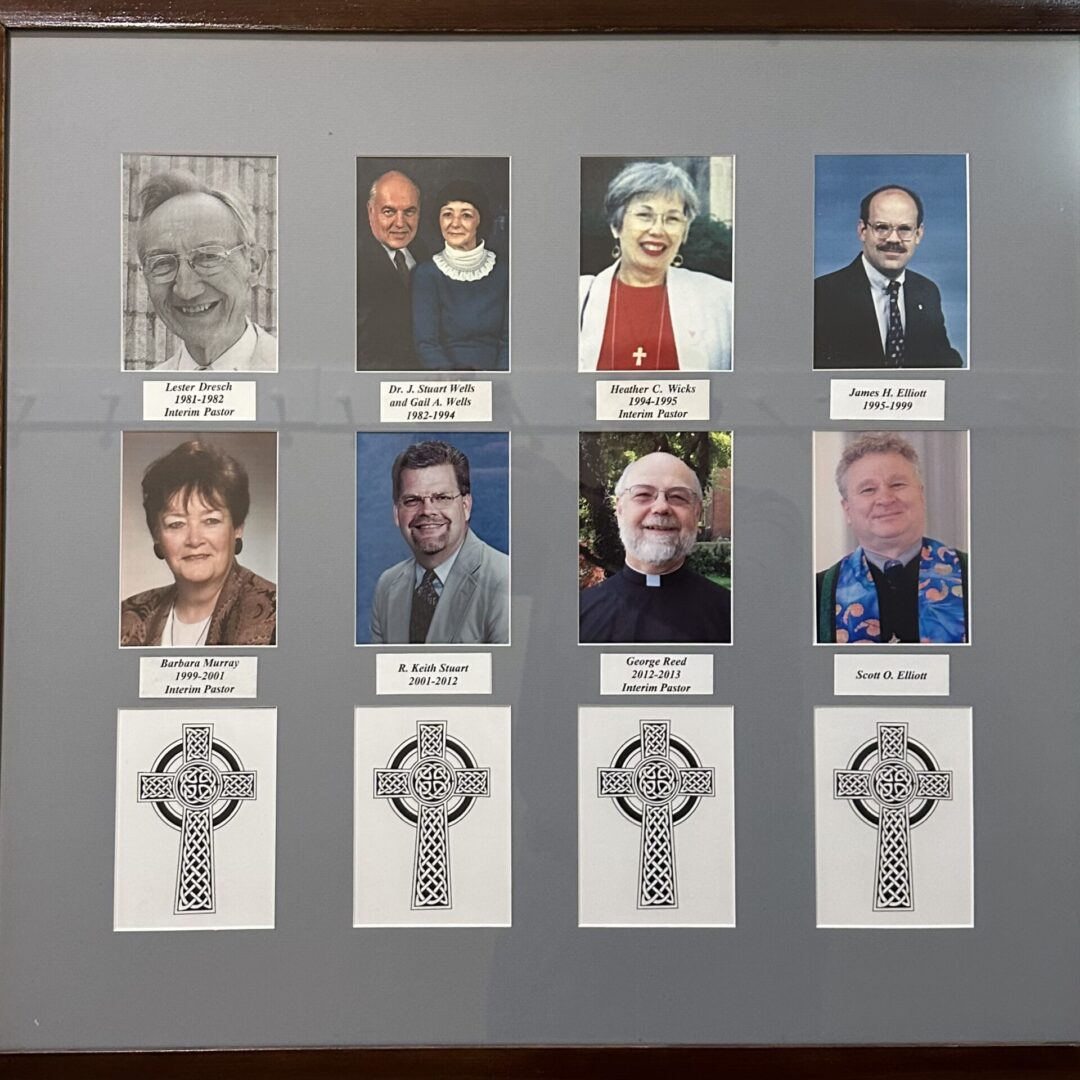
Historical Sketch
By Elwell O. Mead
From the Manual of The First Congregational Church, Mount Vernon, Ohio 1924
Historical Sketch
By Elwell O. Mead
From the Manual of The First Congregational Church, Mount Vernon, Ohio 1924
When the church came into existence there were in Mt. Vernon three, perhaps four other church organizations. The Presbyterians were first in the field and began their religious life with the beginning of the community. Their first pastor, Rev. James Scott, began preaching to them occasionally in 1806. In that year or the next their first house of worship, probably the first in the county, was built of logs, with floor of bare earth and sawed logs laid on it for seats. The church was organized in 1808 and Mr. Scott remained its pastor till 1840. The first Methodist Episcopal minister, Rev. Enoch Ellis, came in 1812 and the first Methodist house of worship was erected in 1831 where the High School Building now stands. Bishop Chase visited Mt. Vernon June 21, 1825, and preached, and on June 10, 1829, the Protestant Episcopal church was established. The Methodist Protestant church is supposed to have been organized in 1832. At the first Court of Common Pleas held in the county in May, 1808, William Thrift, a Baptist minister, was authorized to solemnize marriages, but the Baptist church was not organized till six months after the Congregational.
This church was born in a period which has well been called “a stormy epoch.” The religious life of the nation was agitated by storm after storm in the quarter of a century beginning with 1825. In 1826 the country was stirred through and through by the disappearance of William Morgan after his exposure of Free Masonry. Beginning the same year the Disciples swept over large tracts of Ohio and the Mormons followed, leaving devastation in their track. Especially did the Baptists suffer from these onslaughts in Ohio. It was in the same year too that the opposition to intemperance began to trouble the peaceful waters of the life of many a church. It was in 1827 that the young Fairchilds in Brownhelm first heard of a temperance pledge. Subscriptions in whisky for church building and installation services soon ceased and even the cider barrel disappeared from some church homes.
This was an area of church discipline and Come-outerism. Lines were closely drawn. The way to preserve Christian integrity seemed to be to separate. There was contamination in the touch of those who believed or behaved differently. One church had members on trial for no less that fifteen offenses ranging from whispering and writing notes in church to fighting a duel. Seceding was the natural complement of excommunication. Congregationalism was so closely allied to Presbyterianism by “The Plan of the Union” that our churches felt in bondage and the Come-outers formed both Free Congregational churches and Free Presbyterian churches. In southern Ohio, Congregational churches were and have been so scarce that even in my day the question has been asked down the Ohio river if there was any way to form a Congregational church except by secession from a Presbyterian. While some of these separations grew from church quarrels by far the larger part of them was due to differences of opinion concerning slavery. In many Presbyterian folds under the plan of union were groups of Congregationalists whose innate sense and principles of liberty could not be suppressed. They could not be passive. Their century and a half of training in the doctrine of the rights of every individual blazed forth in aggressive action and the chief feature of the history of Come-outerism as it concerns us is that we have quite a number of Congregational churches in Ohio which originally were Free Presbyterian, having separated from the mother church on account of their desire to move more rapidly and aggressively against slavery than the Presbyterians were willing to move. The exodus of students from Lane Seminary, the Presbyterian Theological school at Cincinnati, because discussion of slavery was forbidden there, gave the church its first two pastors. The anti-slavery storm was the most prolonged and profound and prevalent of the stormy time. Its mutterings had grown to reverberations by the time this church was founded and before the storm subsided it had affected the country with the force of an earthquake.
Of the immediate period of the organization of this church Dr. Strieby said at the celebration of its fiftieth anniversary:
“You of this day cannot understand the local history of the past without a wider survey. This church was formed in the year that introduced what has justly been styled the “Martyr age of America’ when freedom of speech in regard to slavery, was met by social, political and ecclesiastical ostracism, by the destruction of property, by personal violence, and by death itself – then began that era of riots, mobs and persecutions that had its culmination in the storming of Fort Sumter and the civil war and its end in the overthrow of slavery.
Let me sketch some of these riots: On July 4th, 1834, a meeting in Chatham street chapel, in New York City, was broken up by a mob. On July 9th the house of Lewis Tappan was ransacked and furniture burned in the street, and the churches of Dr. Cox and Rev. Mr. Ludlow stoned, and the houses of some colored people destroyed. August 13th, a riot occurred in Philadelphia, lasting three nights. The houses of blacks were destroyed and themselves assaulted and one killed. October 12, 1835, a female anti-slavery meeting in Boston was mobbed, and Wm. L. Garrison was dragged through the streets with a rope around his neck. On the same day a mob dispersed an anti-slavery meeting in Utica, New York, some of the people finding refuge in Peterboro, the home of Gerrit Smith. On November 17, 1838, Rev. D. P. Lovejoy, after suffering shameful and repeated persecutions, was shot dead in Alton, Illinois. On May 17, 1838, Pennsylvania Hall in Philadelphia was burned by a mob, because it had been used for holding an anti- slavery meeting.
All this while other scenes and influences marked these days; the year 1834 being the brightest period in a wonderful era of religious revivals, to which the growth of the American churches is due in a large measure. From 1824 to 1834 witnessed the labors of many eminent men as revivalists, none more useful than a young infidel lawyer living in the northern part of the state of New York, named C. G. Finney, whose remarkable conversation was followed by earnest labors, and earnest pleadings that let many souls to Christ. He came to Oberlin College as a member of the faculty in the year 1835, but still continued his work as an evangelist. Oberlin College has had much to do with the history of this church, most of its pastors receiving their education at Oberlin, and the members of this church furnishing many pupils to the school.”
The founders of this church must be described in order fully to understand its history. Most of the members were Presbyterians from Western Pennsylvania, two families constituting a majority of members of the church in the early days, including by intermarriage the McGibeny’s, Scotts, Newells, Marquises, Murphys’, Lewis’s, Trimbles, Days and Conklings. This company of people were restless not only because the church with which they associated would take no aggressive measures against intemperance and slavery but also because of the doctrine of foreordination and the lack under it of evangelistic effort.
The leader of the movement was Judge McGibeny, although the Newell family was most numerous. The Judge’s wife was a Newell as was also the wife of Allen Scott, the wife of Edward Marquis and the wife of James Adams. These four sisters and one brother with their families made a majority of the early company. The most of them with some of the Murphys and perhaps others, before the church was organized went to the barn of a man by the name of Bird on the Columbus road nearly opposite or just beyond where the County Infirmary now stands and partook of the sacrament of the Lord’s Supper. Elias Murphy remembers distinctly that he and his chum, Hugh Scott, the son of Allen Scott, were there. This was probably in June. Events cam rapidly. The church was organized July 26, 1834, with 30 charter members and 14 more were received in August. In four months, they secured a pastor, Rev. B. W. Higbee, one of the students in the exodus from Lane Seminary to Oberlin. He was of medium stature, strong physique, energetic in body and mind. At that period the roads were almost impassable in the spring, but nothing checked his activity. Wherever in the country within reach could be found one of the new faith there Mr. Higbee would go, afoot or on horseback along the road or across lots and preach or hold prayer meetings with whatever congregation he could gather. His wife was ill when he came but she would let no one of the family where they were entertained stay at home from the preaching service on the evening of their arrival. She died a few days afterward and James Martin says the spirit of that funeral expressed in the prayer was “The Lord gave and the Lord hath taken away. Blessed be the name of the Lord,” and there was hardly a dry eye in the house.
The first communion service, after the arrival of the pastor, was held in the Methodist Episcopal house of worship on the lot where the High School building now stands. At that meeting in January, 1835, eleven
members were received. Ten more followed in February and others in April, August, November and December. Judge McGibeny, foremost in every good work, bought a lot and gave it to the church and the work of gathering material for a house of worship was begun and work was pushed fast enough so that it was occupied in 1835. Most of the members were farmers and the subscriptions were largely in timber, stone and work. Even some of the farmer girls helped load logs to be made into lumber. James Martin and Edward Marquis were among those who hauled the lumber. The basement was finished so that the meetings could be held in it some time before the upper room was finished. Here the first great revival meeting of the church was held. The dissenters, who formed the nucleus of this new band, had deplored the lack of special efforts in the old church, and they began this kind of work and kept it up as long as they were ruling spirits in the church, to the steady growth and great good of the church.
Dr. Henry Conkling went on horseback to Oberlin in December, 1835, leading another horse to secure help in conducting evangelistic meetings. He came back with President Mahan on the other horse and the meetings which followed resulted in about 60 hopeful conversions, 49 united with the church in January, 1836, and 15 more before the following winter. In these days and for some years the members were wont to gather early Sunday morning and hold a prayer meeting before the minister arrived. Judge McGibeny was among the earliest comers and frequently led this introductory service.
In March, 1836, while Rev. W. T. Allen, a son of an Alabama slave-holder was lecturing in the basement of the church, the first mob in Mt. Vernon attacked it and the meeting was broken up, but while the crowd was being collected, by the strains of martial music under a banner bearing the inscription “No Discussion,” Allen escaped. While the eggs and clubs were flying and the mob was trying to put a rope around his neck with which to drag him out and hang him, the women crowded around and kept the mob off, acting as a bodyguard until he got into the street. Here he was able to elude the mob, but they pursued him to the residence of David Drake north of town. He passed through the house and shielded by it disappeared in the woods. Mr. Drake invited the pursuing crowd in, bade them search the house and at last showed them the way to the cellar where some of the leaders plunged into the darkness and into two feet of water with which the cellar was flooded. Then they gave up the search and were treated to a lunch of bread and butter in the door yard and returned to town in good humor.
The second attack by a mob occurred in January, 1837. Prof. Wm. Cochran of Oberlin, while addressing an anti-slavery meeting in the church was interrupted by what was known as the Mt. Vernon Meat Axe Club, who by hurling stones and missiles of various sorts, smashed windows, put out lights and succeeded in breaking up the meeting. Prof. Cochran escaped, but the ugly crowd of marauders were so incensed at their failure to capture him that they hastened to the home of Dr. Baxter in Miller township where he had an appointment, assailed the house and shamefully maltreated Dr. Baxter. The next night Prof. Cochran had an appointment at the house of David Bixby in Pike township. Here the raiders again made an attack, broke in the doors, struck Mr. Bixby to the floor twice and so frightened and clubbed his wife that her life for a time was despaired of.
These mobs were so noisy that they were sometimes heard at the home of Edward Marquis three miles from town, and so brutal and reckless that bands of young men, acting as body guard conducted the pastor to his home many a night after service, and so regardless of property rights that Charles Cooper and others stood guard to defend the church from their attacks and sometimes drove them off in a rough- and-tumble skirmish.
Pres. Mahan held a second meeting in the church in December, 1837, from which it was greatly strengthened. Pres. Finney and wife were here for a few days, not far from this time, and also Prof. Henry Cowles. Pres. Jas. H. Fairchild preached at the dedication of this edifice in 1868. In later days Prof. Currier has been the patron saint of the church, and of the church’s thirteen pastors, no less than ten have received all or part of their training at Oberlin.
After four years of militant service Mr. Higbee was succeeded by Rev. Edward Weed whom he had recommended. Mr. Weed, another of the students of the Lane Seminary exodus, was a man of delicate, pleasant appearance, sociable, friendly and affable, and had a strong hold on the community. At the fiftieth anniversary, Dr. Strieby said of him, “His pastorate might well be termed the peaceful era of the church. He was of medium size, finely formed and a most lovable man in manner and disposition.” In the autumn of his first-year’s service he held a series of special meetings, lasting four weeks, in which he was assisted by Rev. John T. Avery. 57 members were added to this church and many to other churches. While Mr. Weed was pastor, the Cooper family was added to the church and on his retirement in 1842, the church numbered 250 members.
The next pastorate was that of Rev. M. E. Strieby, who like Mr. Weed, was recommended by his predecessor. He told his own story of his work at the fiftieth anniversary, in the following words:
“My pastorate began in 1842 and continued until 1853, and in June of my first year, during a session of the Ohio Anti-Slavery Society, I had my first experience with a Mt. Vernon mob. The meeting was held in the old church, many influential citizens of the town being present. During the progress of Leicester King’s remarks a crowd gathered without and began pelting the building with stones and eggs. Mr. King who was speaking, after vainly endeavoring to be heard, at last retired with the remark that this kind of a reception did not suit him, and nay one else was welcome to the platform. He was followed by Rev. Edward Smith, who pointed to the double doors which stood open, exclaiming, ‘Shut those doors, don’t give the mob that advantage,’ and then proceeded in spite of the shower of eggs, with the remark ‘Every egg will make an Abolitionist.’ The meeting finished its business and adjourned regularly.
During the year 1843 a revival occurred, adding nearly thirty members to the church. Then followed six years of stagnation, and but for the faithful few who encouraged the pastor by their assistance and prayers, the church would have become a veritable valley of dry bones. In January, 1849, union meetings were inaugurated by the different churches of the city, but no result being apparent, the pastors of other churches became discouraged and withdrew. It was determined by the pastor and a few members of this church to continue them. Sixty-three meetings were held, and by God’s help ninety souls were added to the church at one communion and many influential converts went to other churches. In connection with the meetings young men held prayer meetings at their stores and offices, one of those active in the work being the now distinguished statesman and Christian gentleman, Hon. Wm. Windom.”
Among the foremost of the members in this work was Wm. Turner, who carried the church on his heart and served as Deacon, Sunday School Superintendent and Clerk with untiring devotion. He was, as Judge McGibeny had been, for many years the acknowledged lay leader of the church in spiritual matters.
The meeting which gave Mr. Strieby his first experience with a Mt. Vernon mob was the state convention of the Liberty party, and quoting in substance Deacon Bonar, “Despite the howlings of the crazy mob and the shower of rotten eggs, they continued their deliberations and nominated Leicester King for governor, and so effectually withstood and put to rout the disturbers that mobs and the Meat Axe Club were no more in Knox County.”
After the first egg had hit the speaker and conditions were becoming very uncertain, Mr. D. L. Travis went out. The first man whom he saw outside was Charles Cooper. “What are you doing here” said Mr. Travis. “I am taking care of this church” said Mr. Cooper (and that is what he kept on doing as long as he lived.) Just as he spoke he turned and confronted one of the raiders on the north side of the church, and in an instant the raider was rolling down the bank into the street, propelled thither by Uncle Charles’ toe. The action was summary enough to frighten the mob away. On that same night a load of 19 fugitives which had been brought from Appleton the night before in a double wagon by 12-year-old John Scribner, were taken on toward the North Star by Mr. Travis, under the cover of storm and darkness.
In the next to the last year of Mr. Strieby’s pastorate, a prohibition convention was held in the church, which nominated Joseph W. Vance, of Mt. Vernon, for state senator, and A. Greenlee, of Fredericktown, for representative, pledged in favor of the Maine temperance as in its anti-slavery principles and has always had a Standing Rule forbidding the sale, furnishing or use of intoxicating drinks by its members.
In this pastorate the organization was changed from that of the Free Presbyterian to that of the Congregational, the change being completed April 30, 1849, though there are still traces of Presbyterian influences in its form of government. Its present mode of government is perhaps best fitted to its own work and field, but it is not as purely democratic as that of unadulterated Congregationalism. It was eminently fitting that this church, conceived by the abolitionists, born in the throes of the anti-slavery agitation and cradled in its conflict should furnish one of its pastors to the Secretaryship of the American Missionary Association. After eleven years of steady and valuable service Mr. Strieby closed his work with the church, and after a pastorate in Syracuse, New York, spent the remainder of his life in the wider service made necessary by the results of the anti-slavery agitation.
Of his successor I have found only this statement: “Rev, S. C. Leonard succeeded Mr. Strieby in 1854. This pastorate was distinguished rather by the ability of the pulpit exercises and faithful seed sowing than by large ingatherings. An organ was placed in the church while he was pastor, costing $875.” He was pastor for five years, and revisited the church at the dedication of its second edifice in 1868, and preached a most acceptable sermon.
After a year’s interim he was succeeded by Rev. Thomas E. Monroe, who will also be allowed to tell us his own story, in the words, if not with the voice that he used at the fiftieth anniversary.
“In the spring of 1860, when a young graduate of Oberlin, I received a letter from Br. Wm. Turner, inviting me to attend the next communion service of the then unknown to me Mt. Vernon church, on the last Sunday of March. I accepted the invitation and on the following Monday was invited to accept the pastorate of the church. After much hesitation I accepted the call, and in September following took charge of the church.
When I assumed the charge, the congregation had become scattered, many having taken pews in other churches, expecting that the membership had fallen to about one hundred and fifty, mostly elderly people. No young people were connected with the church, and the Sunday-school was almost dead.
In the spring of 1861, after two and a half days visit to Lock, I returned home to find that death had invaded the congregation, one of our loveliest and most earnest young Christians, Laura Turner, having been attacked and died with malignant diphtheria. My grief was lessened by the peculiar message she left for me: ‘Tell Mr. Monroe that I will pray the Savior to bless his labors.’ On Sunday evening after her death, prayer meeting was held, and twelve young people remained for personal conversation. This was the beginning of the glorious influence exerted by that young soul for good, and as a result of the four weeks’ meeting following, fifty-five of her fellow pupils of the High School united with the church, and as great a number with other churches. From this beginning and from the influence of this young Christian, could be dated the commencement of the present prosperity of the church. The kitchen was fitted up for the infant class and the basement floor covered with and elegant new rag carpet, the work of willing hands of the ladies of the congregation.
During the spring of 1861 the church was turned into a tailoring shop, manufacturing blouses and scraping lint for the brave volunteers who went forth at their country’s first call. Teams were sent out into the country for blankets, and among others visited was that good Quaker brother, Birthday Combs, near Fredericktown. The conscientious Quaker would not give any blankets for war purposes, but said: ‘The blankets are upstairs, and if thee takes any, take good ones.’ David Bonar said to his father: ‘Your principles have brought on this war, and you should not refuse any sacrifice!’ and after taking leave of the old home the boy went forth to die at Arkansas Post, the first offering of this church upon our country’s altar. Of the fifty-nine young men furnished by this congregation to fight for the right and liberty, thirty have died as a sacrifice.”
The Emancipation Proclamation put an end to the institution which had been mainly the cause of the church’s existence. It has felt that the church should enter on a new era. The leaders wanted it to stand as prominently for the whole work of Christ in the community as it had for the despised cause of Abolition. To this end a new house of worship was proposed. After thorough discussion by the whole church in numerous meetings it was voted to build John Cooper, Orlo Sperry and Walter Smith were chosen as Building Committee. John Cooper gave $1,200 for the lot on which the church stands and presented it to the trustees. The first call for funds was enough to enclose the building, the second to finish the interior and a third was found necessary before the work could be completed. This third call was participated in by Mr. Strieby, who by appearing on the scene surprised all save the ones who had quietly invited him. The committee watched over the progress of the work with exceeding care and faithfulness. It took three years to finish the edifice. John Cooper gave nearly one third of its entire cost and yet no one insisted more strongly than he that everybody should stand on equal footing in the new house of worship. From that day to this the pews have been free and uniform in appointments. The church sold its old house of worship to the Methodist Protestants, and worshipped during the las year or so of the building of the new church in the house owned by the United Presbyterians who had given up trying to maintain a church in Mt. Vernon. The building is now the Public Library. Some of the spirit of sacrifice which characterized the people who built the Mulberry street edifice remained. Elias Murphy hauled the half million brick which went into it as his contribution. His brother Thomas hauled the water, lime and sand. Indeed, the members of small means gave more liberally in proportion to their ability than the more prosperous. One man went without an overcoat to pay his subscription: the ladies made the cushions and fitted and laid the carpets with the assistance of the pastor and one or two other men. The thoughtfulness for others which has characterized the church, found expression in the sentiment: “We are building large and strong because we are building for our children as well as for ourselves.” Mr. Monroe’s pastorate was pre- eminently successful in all ways and when he left the entire cost of the building, $32,000, had been paid and there were 422 members.
His successor, Rev. I. C. Billman, remained less than two years. His pastorate marked the only epoch of division and discord which the church has known.
Rev. E. B. Burrows came in 1875, stayed till 1879, and revisited the church at the time of its semi- centennial and made two addresses. He was a man of delicate spiritual insight and sympathy and a very able preacher. His wife was the daughter of Gov. Thomas Corwin.
Rev. R. T. Hall was installed Nov. 11, 1879, and at once began a vigorous and wise administration, which together with his strong preaching, did much for the church for a number of years. In his pastorate the parsonage was built at a cost of $7,500 and the semi-centennial was celebrated. The meeting was a great and good one in every way. The attendance was immense, the decorations profuse and elegant, the sermons and addresses of a very high order, the reminiscences thrilling, the music the best in Mt. Vernon, the banquet a feast of culinary and literary delicacies. In his pastorate the membership became a little larger than it had been before, and the missionary offerings of the church were a thousand dollars yearly. He closed his work about a year after the semi-centennial.
Re. Edward I. Bosworth began a promising pastorate in 1886 but resigned in about nine months to accept a call to a professorship at Oberlin where he has ever since served with steadily increasing success.
He was succeeded by Rev. Sidney Strong, who, for five years, 1887–1892, worked with the enthusiasm, vigor and ambition of youth. His policy was aggressive and outreaching and he brought himself into sympathetic touch with even the poorest and least privileged. In the last year of his pastorate, he secured the assistance of evangelists Reed and Chafer, and as a result of these meetings about seventy-five were added to the church. When his pastorate closed the church had a hundred more members than at it beginning and about forty more than it ever had before, but because Mr. Strong left so soon after the large accessions or for some other reason an unusually large number of those received in his pastorate have dropped out of church life.
Rev. Wm. J. Turner followed with another five years pastorate, 1893-1898, coming from Nebraska and at its close returning to the same state. He was sincere and earnest, and had the true interests of the kingdom of God at heart. He found a large and warm place in the hearts of not a few in the church and community, but the life of both church and community at this period presented many grave and perplexing problems which so occupied attention that progress in the church was very difficult. The beautiful stained-glass windows of the church stand as a monument to his leadership as well as memorials to many worthy members.
Rev. S. C. Dickinson’s three years pastorate, 1899-1902, was shortened by the critical illness of his wife, removal to Colorado being deemed necessary to save her life. He was one of the most unselfish of men and loved by everybody. His sermons to children were always beautiful and enjoyed by adults as well as children. His influence was entirely wholesome and his friendship is richly treasured.
By Mrs. Henry Cooper
Mr. Dickinson’s resignation came in April 1902, and Rev. Elwell O. Mead came to the pastorate in December of the same year. At the annual meeting in January, 1903, Mr. Mead asked that a committee be appointed to revise the constitution, By-laws and Creed of the church. He with Mr. B. B. Williams and Mr. C. F. Colville were appointed. In October, 1903 the new manual as prepared by the committee was adopted by the church at a regular business meeting. Mr. Mead also wrote a very interesting historical sketch of the church which was incorporated in the new manual. Electric lights were placed in the church and other needed improvements made during his pastorate. In the winter of 1908, the church united with the other Protestant churches of the city in making preparations for a great revival meeting. A large tabernacle was erected on the court house lawn and the Rev. Milton Lyons, a noted evangelist was secured. At the close of the meetings a large number united with the church, but for some reason but a few seemed to grow into the life of the church and the results were not of much permanent value. In January, 1910, Mr. Mead tendered his resignation after seven years of faithful service. He was a close student of the Bible, having broad and scholarly views of its teaching which he ably set forth in the pulpit.
After a short interim Rev. Ira J. Houston received a call and came to the church June fifth of the same year. The old parsonage on North Main St. was now sold and the present one on East High St. was purchased. In June 1911 the Presbyterians were invited to join with the church in union meetings while they were rebuilding their house of worship. The invitation was accepted and the churches met together for one year. During this pastorate the Congregationalist and Advance were placed in the Public Library and Y. M. C. A. In August 1915 Mr. Houston having received a call to a larger field of service presented his resignation to the church. He had given five year of earnest work and formed many pleasant associates. He was succeeded by the Rev. M. S. Freeman who was called to the pastorate in January 1916. During his stay the church was given many needed repairs. The outside being transformed with stucco work and a tower replacing the original spire which had been struck by lightning.
Mr. Freeman was a strong and interesting preacher and also took active part in the work of the Y. M. C. A., Red Cross and all civic affairs. His resignation in 1920 was felt as a distinct loss, not only to the church but to the whole community.
The Rev. David Pike came to the church in September of the same year and has been an untiring worker and an excellent pastor and preacher. Hoping to increase the attendance and interest in the evening service Mr. Pike introduced the first moving pictures to be given in a Mt. Vernon church.
The ninetieth anniversary of the Church was celebrated on Sunday and Monday, September 28th, and 29th, 1924. The Rev. Marston S. Freeman, serving the Congregational Church of Chattanooga, Tenn., spoke on Sunday morning, taking as his subject “The Spiritual Under-currents of Ninety Years Ago.” The speaker in the evening was the Rev. McIlyar B. Lichliter of the First Congregational Church of Columbus. His subject was “In The Wake of The Mayflower.” There was a special service in the Sunday School, in which Mr. Zenno Taylor gave an address honoring the former members of the Church whose portraits hang in the vestry.
On Monday evening a re-union banquet was held at which about 225 persons sat down. The Reverends Elwell O. Mead, Selden C. Dickinson, and Marston S. Freeman were present and spoke in happy vein concerning their memories of the Church. Other speakers were the Rev. Edgar S. Rothrock, representing the State Conference and Rev. Hugh Wayt who gave the greetings of the local Ministers Association. Mr. Henry Cooper read an historical poem which was highly appreciated.
Notwithstanding continuous rain, the meetings were all finely attended and the whole celebration was characterized as one of the most successful and happy events the Church has known for many years. As part of the anniversary celebration Mr. Hal Eggleston, Mrs. W. S. Sperry and Mis Florence Westlake were appointed to prepare a new manual of the Church.


